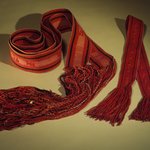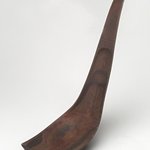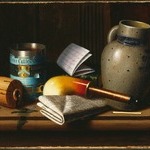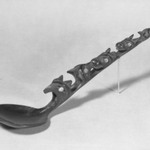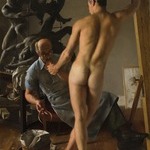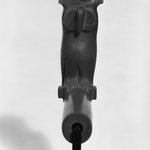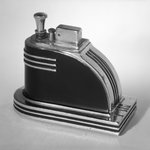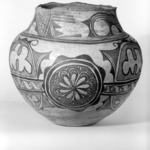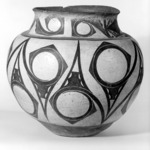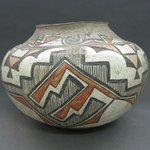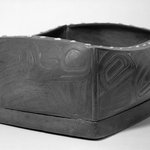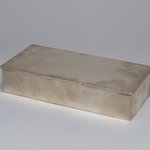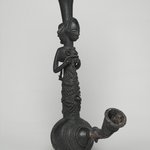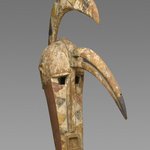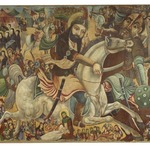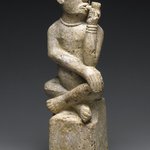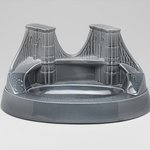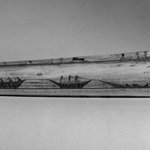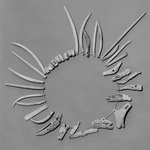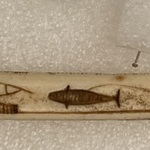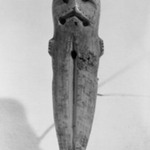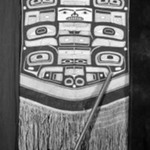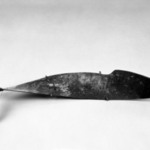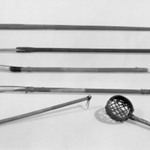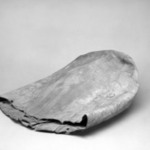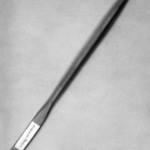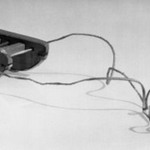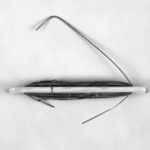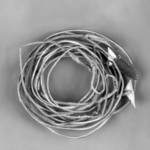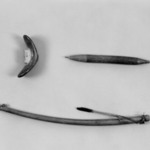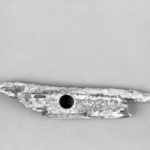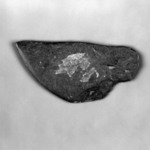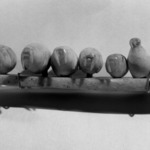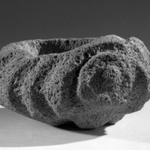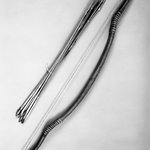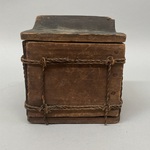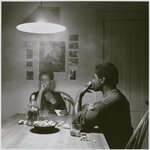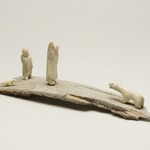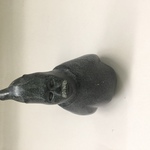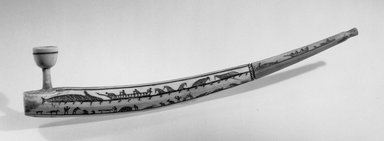
Pipe
Arts of the Americas
These Native American objects represent just a few of the items made in the late nineteenth and the early twentieth century, primarily for sale to dealers and collectors to satisfy the growing market for indigenous products. Finely coiled baskets like the example by the Maidu weaver Mary Kea’a’ala Azbill were in great demand, as were Zuni Kachina dolls. The desire for Eskimo objects such as the ivory pipe engraved with a whale-hunting scene was accelerated by the Klondike Gold Rush in 1897. To appeal to non-Native patrons, Native artists invented new designs using trade materials such as the glass beads forming the embroidered floral arrangement on the northeastern puzzle bag (so named for the way its pieces fold together to keep it closed). Other artists used traditional materials but tailored designs to non-Native aesthetics, as seen in the porcupine-quill box. The Navajo quickly adapted to the Spanish introduction of silver coins and silver mining in the seventeenth century, embellishing their traditional wrist guards with hammered silver. Some artists retained both traditional materials and designs but produced greater quantities of popular items such as the Plains owl pipe bowl made from Catlinite (red pipestone).
CULTURE
Alaska Native
MEDIUM
Ivory, ink
DATES
late 19th–early 20th century
DIMENSIONS
10 5/8 x 6 1/8 in. (27 x 15.5cm) (show scale)



COLLECTIONS
Arts of the Americas
ACCESSION NUMBER
22.1797
CREDIT LINE
Brooklyn Museum Collection
CATALOGUE DESCRIPTION
This is a curved pipe with a bowl shaped like a knob on a slender pole. Along the stem of the pipe are carved scenes of whale and walus hunting and village scenes with food preparation.Pipes like this were used but also made for trade.
MUSEUM LOCATION
This item is not on view
CAPTION
Alaska Native. Pipe, late 19th–early 20th century. Ivory, ink, 10 5/8 x 6 1/8 in. (27 x 15.5cm). Brooklyn Museum, Brooklyn Museum Collection, 22.1797. Creative Commons-BY (Photo: Brooklyn Museum, 22.1797_view2_acetate_bw.jpg)
IMAGE
overall, 22.1797_view2_acetate_bw.jpg. Brooklyn Museum photograph
"CUR" at the beginning of an image file name means that the image was created by a curatorial staff member. These study images may be digital point-and-shoot photographs, when we don\'t yet have high-quality studio photography, or they may be scans of older negatives, slides, or photographic prints, providing historical documentation of the object.
RIGHTS STATEMENT
Creative Commons-BY
You may download and use Brooklyn Museum images of this three-dimensional work in accordance with a Creative Commons license. Fair use, as understood under the United States Copyright Act, may also apply.
Please include caption information from this page and credit the Brooklyn Museum. If you need a high resolution file, please fill out our online application form (charges apply).
For further information about copyright, we recommend resources at the United States Library of Congress, Cornell University, Copyright and Cultural Institutions: Guidelines for U.S. Libraries, Archives, and Museums, and Copyright Watch.
For more information about the Museum's rights project, including how rights types are assigned, please see our blog posts on copyright.
If you have any information regarding this work and rights to it, please contact copyright@brooklynmuseum.org.
RECORD COMPLETENESS
Not every record you will find here is complete. More information is available for some works than for others, and some entries have been updated more recently. Records are frequently reviewed and revised, and we welcome any additional information you might have.
